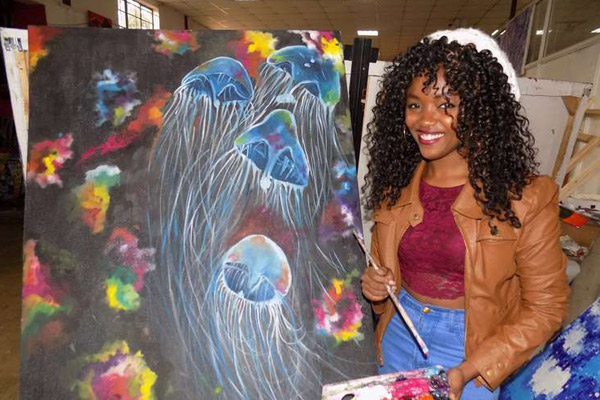Share this
Sylvia Mwihaki is a psychology student at USIU-A. When she is not in class, you will probably find her creating interesting pieces such as these. Art, she says, is her life, a childhood dream come true.
The painting psychologist
Sylvia Mwihaki, 20, always knew she wanted to be a painter, she just did not know how to go about it.
“From a young age, I liked to draw things, and when I joined school, I developed an unwavering liking for arts,” she says.
Her art teacher at Brookhouse School saw her interest and encouraged her to give the skill her all. The teacher, who was an all-round artist, not only taught her to draw, but also taught Sylvia and her classmates pottery. Though pottery was interesting, Sylvia ended up falling in love with painting, and by the time she left primary school, she had decent exposure to the world of arts – it was only a matter of ‘when’, not ‘if’ she would pursue painting as a serious career.
She proceeded to Greensteds International School, and as expected, art was her favourite subject and her art teacher her favourite tutor.
“At some point, my art teacher was involved in a road accident, which affected his memory. He later wrote our class an email, and specifically mentioned me – he told me that he had started an art school in Nairobi, which he invited me to join – I was thrilled that he had noticed my passion for arts,” she recalls.
After high school, she spent three months sharpening her painting skills, however, her mother did not view painting as a “real” career, and insisted that Sylvia enroll for an alternative degree as a back-up plan.
“I wanted to travel to the United Kingdom for a degree in arts, but my mum wanted me to join United States International University (USIU-Africa) instead. Eventually, we came to an agreement that she would allow me to continue learning art as I pursued a degree of my choice from the university,” she says.
She chose to study a Bachelor’s degree in Psychology, joining university in 2013.
ART THERAPY
“I started searching the Internet for ways I could marry my passion for arts with what I was studying, that is how I stumbled on art-therapy.”
Art therapy is a form of expressive therapy that uses the creative process of making art to improve a person’s physical, mental, and emotional well-being.
One day, she came across fascinating graffiti on one of the walls at the university. Awed by the talent she saw, she traced the piece of art to PAWA254, a local organisation that supports and promotes arts and culture among young people.
She got in touch with them and joined the organisation for a month-and-a-half to watch and learn more about it.
Later, her curiosity and insatiable urge to improve her art led her to YouTube, where she stumbled on Michael Lang’s YouTube channel.
“I was searching about abstract painting when I found him. His videos are detailed, and I loved what he painted. I watched and practiced every one of his techniques, though I infused my touch. If not in class, I was on YouTube watching his videos. I did that for about three months,” she says.
The YouTube lessons paid off handsomely; she sold five paintings in her first exhibition at Nairobi’s Arboretum during the Cake Art Affair event in February 2016, no mean feat for a beginner. Every piece of art had a distinct theme. Her most expensive painting, dubbed Timeless, consisted of several clocks to show that sometimes time does not matter, that what matters is the experience at that moment. It fetched Sh15,000, which got her doing a little dance. The second one was a painting depicting a couple spending quality time together.
“Many wanted it, and I ended up making three copies of it. Each piece went for Sh8, 000,” she says.
So far, she has participated in five exhibitions alongside seasoned painters. They include Nairobi Art Market, which took place at Lavington Mall on June 24, 2016, and Dust Dipples, organised by top Kenyan artist, Patrick Mukabi at Alliance Française de Nairobi, on May, 1, 2016, to showcase his students’ artworks. Sylvia is one of Mukabi’s protégés; he is the prolific painter behind the Java Coffee House paintings. She has also exhibited at Michael Joseph Center and the Art Cocktail event at Memorial Park in April this year.
AFRICAN-FEEL
The fourth year student of psychology is proud to be the only student whose paintings grace the walls of the USIU-K’s student cafeteria.
“The paintings are two; the African Water Lily and Circle of Life, done in bold colours. I wanted to bring out the African-feel,” she says.
The project was fully funded by the university, money she used to buy painting equipment.
Her most prized piece of art so far fetched Sh74, 000, and hangs at the café in Alliance Française de Nairobi.
“I do abstract paintings, hyper-realism and expressionism, which are the most popular forms of paintings in the world,” she explains.
Abstract painting advocates for an artist’s creativity and breaks away from other forms of painting as it does not represent recognisable images. Hyper-realism paints a picture the exact way it looks like, while in expressionism, an artist seeks to express emotional experience, rather than impressions of the external world.
What does it take to become a painter?
You need to be passionate about it; you also need to be business-oriented. This is a business like any other, so you have to be ready to face all those challenges that come with it for you to succeed. You have to have faith for it to work out. You also need to be ready to sacrifice lots of time and money. I have spent over Sh50,000, from my savings on painting materials for instance. Sometimes, I turn down my friends’ invitations to hang-out because I feel this (painting) is more important.
Where do you get your ideas on what to paint from?
I think about what I want to paint and then I go online and find something that appeals to me.
Is painting fulfilling?
I do know that it doesn’t seem like work. The only time that it feels like work is when I get a mental block.
What is the most exciting thing about painting?
Doing something that you never thought you could do. The thing with artists is that they are very visual people. Sometimes I can see something over and over again but tell myself I can’t paint it, only for me to manage it – this completely shocks me. That feeling is really good because it is new every time. It is like pushing your limits. What I love most about painting though is seeing the look on people’s faces when they see my paintings.
What challenges do you face as a painter?
Getting the right paint is also difficult because we rely on imports, and not so many venders import the types of paints we require. The biggest challenge though is being mentally present. I can go for weeks unable to paint because of artist’s block. You need to be mentally focused; this doesn’t always happen because we are human beings and there are so many external factors that come into play.
What causes artist’s block and how can one get out of it?
It happens the same way writer’s block does; when you want to write so badly but you can’t. To cure it, you need to shake it up. Get up and get out of where you are painting.
Switch off your phone or just do something that keeps you active, for instance playing basketball or just spending some time with your friends. You need to do something that will completely get your head out of it so that when you return, you’re ready to paint. That’s what I usually do.
How do you manage to juggle work and school?
Luckily, in USIU-A, you can choose your classes. I could for instance choose to have classes three days a week and have two days to myself. The schedule is flexible, such that students can work too or pursue other interests.
How lucrative is painting?
Very. There are people out there who love and appreciate art. Do not do it just for the money though. For me, as much as money is a big factor, it is not my number one motivator. You need to have another motivator because money will come and go. Focus on skills, passion and your love for the art.
What would be your advice to young people like you who want to become painters?
First you need to have the skill, talent if you want. If you have this, you will need a business plan. Second, you need to gain knowledge. You need to know where everything art-oriented is, online or offline.
You have to meet and talk to people in the art industry because the only way you will learn is by listening to people’s experiences. Also visit galleries and exhibitions. I visit http://allevents.in/nairobi# for upcoming exhibition events.
Art Cocktail events happen every month and Cake Art Affair event is a regular one. As for galleries, check out Alliance Française de Nairobi, The GoDown Arts Centre and Dust Dipples Studio, which are open daily.
How do you market your paintings?
I market them on my Facebook and Instagram pages. I also keep track of social media to see what is trending and what other artists are posting, and then I go back and make a portfolio of really good pictures of my work and put it out there. This is partly what sells one as an artist.
How do you determine your prices?
I consider how long it has taken me to create the paintings; the size and price of the canvas, the framing, and the paints and other overhead costs. Then I top it up with something little and that way it is fair for everyone.
Who inspires you?
I draw a lot of inspiration from international artists such as Michael Learns, Katy Jade and Peter Terrin— I love their style. It appeals to me more because I love colours and they use lots of it.
How do you ensure you close a sale in every exhibition?
I talk to every person that comes to my stand. I ensure that they understand each and every piece of it. By the time our talk comes to an end, you feel as if you are my friend.
What do you plan to do after completing your degree?
I will start my master’s degree in psychology, (I plan to venture into art-therapy, which requires a master’s degree) but I may take a year off after graduating to concentrate on my painting. No university offers Art therapy in Kenya; I plan to go abroad for it.
What’s in the future for you?
I want to have a solo exhibition by the end of the year. And many more exhibitions so that people can get to know me as a serious artist and appreciate my work. My goal for this year is to make Sh1million.
Source:http://www.nation.co.ke




















